
 |
| SHIP NOTES: (Sources: Gentile, 24) | |
| Name: EMPIRE GEM | Type: Tanker |
| Built: 1941 by Harland & Wolff Govan, Glasgow, Scotland | Owner: British Tanker Company, London, England Home Port: |
| Size (ft.): 463-3 x 61-4 x 33-0 | Gross Tonnage: 8,139 tons |
| Propulsion: Twin screw diesel engine/speed 11.5 knts | |
| Date Sunk: 1/24/1942 | Cause: Torpedoed by U-66 |
| Location Cape Hatteras, NC | GPS: N35° 01.783'/W75° 28.502' |
|
|
|
| SHIP HISTORY; (Gentile, Hickam, Moore, 21) | |||
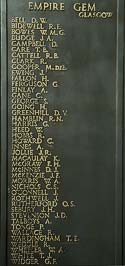
Empire Gem plaque at London Merchant Marine Memorial |
The MV Empire Gem was less than a year old when it was sunk. The tanker was traveling from Port Arthur, TX carrying 10,600 tons of gasoline. It's ultimate destination was the United Kingdom by way of Halifax, Nova Scotia. A veteran of the Atlantic convoys, the tanker was armed with a stern-mounted 4 in. gun, several machines guns and a 12 pound anti-aircraft gun. The Empire Gem had been traveling up the coast in a zig-zag course and overtook the bulk-ore carrier Venore just as the ships were entering the Diamond Shoals area. Little did the crew of the Gem know, but the U-66 had been stalking the Venore. One of the legs of its zig-zag course brought the Gem between the u-boat and its intended target. After sinking the Empire Gem, the U-66 turned its attention back to the Venore who by this time was racing towards shore. It sunk the Venore with its last torpedo. Meanwhile, the Empire Gem was a raging inferno, keeping its forward speed while burning at the stern. The engines were finally stopped, but by the next morning the stern had fallen away and sunk. The surviving crew managed to anchor the blazing bow section, but it flipped over and sank the next day. Only two of the 57 crew members survived. |
||
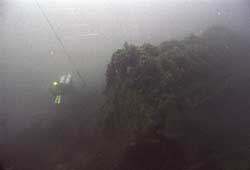 |
 |
||
|
Diver explores the engine area
|
Part of the stern machinery
|
||
|
|
|||
| DIVING NOTES: | |||
| Diving Depths: 120-150 ft. | |||
| Current: none to undiveable | |||
| Visibility: highly variably and dependent on current and winds off the shoals; even when viz is good, the depth and particulates in the water make the wreck appear dark. | |||
| Summer Temperature: mid/hi 70s, but subject to thermocline to the high 60s on the bottom | |||
| Points of Interest: Stern: boiler, engine, 4 bladed propeller and rudder section; Bow:intact and upside down | |||
| Fish/Animal Life: red snapper, sandtigers, lots of black sea bass, tautog, oyster toadfish , amberjacks and african pompano — if the warm water is on or above the wreck; | |||
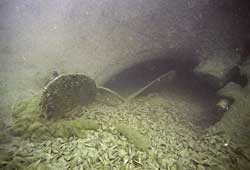 |
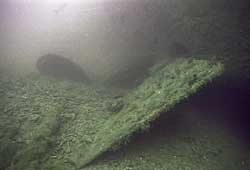 |
||
|
Rudder/propeller at stern
|
Looking straight down the rudder
|
||
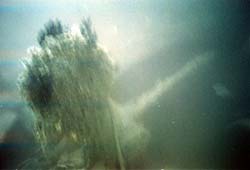 |
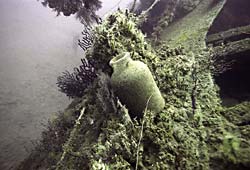 |
||
|
Albeit fuzzy, notice the hub of the prop in this 2002 picture and the 2004 picture above. A couple feet of sand have filled in since 2002.
|
I found this bottle sitting on the starboard (low) edge of the stern fantail. Seems unlikely that it sat there thru the sinking, don't you think? ....but it has been there a long time.
|
||
|
|
|||
| Description: I have dived this 4-5 times and except for one exceptional dive, the viz has been 25 feet or much less. There are reported to be 2 separate pieces. The stern end and the rest of the ship. The stern section is the better dive, as the bow is intact but upside down; I have been on the bow, but viz was so low, I couldn't confirm the orientation or make the jump to the stern, but did discover the :"turtle shell" surface typical of an upside down hull. I am told the stern points towards the two forward sections — prop/fantail points toward the other two sections — 180 degrees from what you would expect; the stern is upright on its keel, laying on its starboard side; the 4 bladed prop and rudder sections are intact and can be seen on the port side; You can still see the curve of the fantail around the stern; the engine, port boilers and fantail appear to provide the highest relief on the stern; this wreck is known as the smell or stink wreck because of the smell of oil that still escapes from the bow section; You can sometimes see the oil slick on the water; | |||

